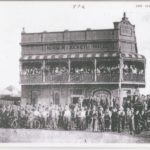When Europeans arrived in 1788 Homebush Bay consisted of extensive tidal wetlands and thick bush. The area was first known as ‘The Flats’, and was recorded by Captain John Hunter within ten days of the arrival of the First Fleet. Although reports of the time commented on the Aboriginal people living in the area, there is little official history of the traditional owners of the land at Homebush Bay.
In 1797 the first grant was issued for land at Homebush Bay. One of the earliest land owners was Samuel Haslam after whom Haslams Creek was named. By 1811 most of the land around Homebush Bay lay within two large estates: the Newington estate to the north of Haslams Creek and the Home Bush estate between Haslams and Powells Creeks.
Newington Estate: In 1807 John Blaxland, one of the first free settlers to arrive in Australia, acquired 520 hectares of land which he named Newington after his family estate in Kent.
Blaxland brought an experienced salt maker with him from England who laid out salt pans on the edge of the Parramatta River. By 1827 the Newington estate was sending eight tons of salt to Sydney each week. The Blaxlands were associated with the estate until the 1860s. In that time a tweed mill and flour mill were established in addition to cattle grazing, logging and coal mining exploration.
Newington House, the Blaxland family’s home and the Chapel of St Augustine, the family’s chapel, survive from this period. Built in 1832 Newington House still stands today in Silverwater Correctional Complex. The house is an excellent example of an early colonial, Regency-style villa.

Home Bush Estate and Racecourse: D’Arcy Wentworth, acquitted of highway robbery in England and sent to Botany Bay as an assistant surgeon, acquired 370 hectares of land between Powells Creek and Haslams Creek in 1810. He named the property Home Bush, and started Australia’s first horse stud.
D’Arcy Wentworth died in 1827. In 1832 his son, William Charles Wentworth, was elected president of the Sydney Turf Club and in 1840 built a new racecourse on the Home Bush estate adjacent to Parramatta Road. With extensive training facilities, the course was the headquarters of Australian racing until 1859, when the Australian Jockey Club moved to Randwick.

The only reminder of the Homebush Race Course is the Horse & Jockey Hotel on Parramatta Road
William is best known for crossing the Blue Mountains and the Bathurst Plains with William Lawson and Gregory Blaxland, brother of John Blaxland. Most of the estate remained with the Wentworth family until 1907.
Government Acquires Land: From 1879 parts of the Newington estate were gradually purchased or resumed by the NSW Government for various uses including an armaments depot. Newington House has served a variety of uses since the Blaxland era, including use as a boys’ boarding school (Newington College), a Benevolent Asylum for Aged Women, a state hospital and, since the late 1960s, an administration block within the Silverwater Correctional Complex.
In March, 1907 much of the land from the Home Bush estate was resumed by the Department of Public Works for the establishment of the State Abattoir.
Newington Armaments Depot: In 1882 land to the east of Newington House was resumed for the establishment of a powder magazine. Operations started in 1897, with the magazine being manned by the Royal Marine Garrison. It was later taken over by the New South Wales Navy and subsequently by the Royal Australian Navy and became known as the Newington Armaments Depot. During World War II the site underwent major expansion. Until the mid 1990s, the depot covered more than 250 hectares and featured 185 buildings, a wharf and a narrow gauge electric railway. Many of the buildings and facilities are historically significant. In early 1997 the armaments depot became an armaments transfer station and consolidated to the north of the site to allow for the development of the Athletes Village. By 2000 the transfer station will leave north Newington altogether and the site will become part of the Millennium Parklands.

State Abattoir: In 1907 the New South Wales Government established the State Abattoir on the Home Bush estate. Situated on what was then the western edge of Sydney, the Homebush Abattoir was the major supplier of meat for domestic and overseas markets for many years. At its peak, the abattoir employed 1,600 people and had the capacity to slaughter more than 20,000 animals daily. In June 1988, the abattoir closed. Many of the old buildings have now been demolished to make way for new facilities. The original Administration Building has been restored by the Olympic Coordination Authority and is now the Homebush Bay Visitor’s Centre. Constructed in 1910, it is a fine example of a Federation style commercial brick building.
The Olympic Stadium was built on the site of the former abattoir saleyards.
State Brickworks: Early this century, increased building activity caused the price of building materials to rise. In order to control the price of bricks, the Government established the State Brickworks at the head of the Bay in 1911. During the economic depression of the 1930s, the brickworks operated at a significant loss. In 1936, they were sold to private enterprise and closed 1940.
After World War II, the Government re-established the State Brickworks due to a shortage of bricks. Two large pits were created to provide the clay to make the bricks. The first pit was closed and filled in during the 1960s. Work in the second pit ceased with the closure of the brickworks in 1988.
This pit is now an adopted home for the Green and Golden Bell Frog and will be a feature of the new Millennium Parklands.
Land filling: The environmental impact of wetland reclamation and land filling has been significant. Over half the existing land area, consisting originally of salt-marshes and wetlands, has been progressively reclaimed. The 1950s saw a huge push to create more waterfront industrial land. Dredging from the Parramatta River filled in large areas of mangrove forest. In the 1960s and 1970s, Homebush Bay became the dumping site for much of Sydney’s household and industrial waste.
1980s: By the early 1980s, Homebush Bay had become a large tract of neglected land which was bypassed as Sydney sprawled westward. The area, now in the geographic heart of Sydney, was earmarked as a major urban renewal project which began with the establishment of the State Sports Centre, the Australia Centre and the opening of Bicentennial Park.
1990s: Sydney’s successful bid for the 2000 Olympic Games has provided the impetus for one of the largest remediation projects ever undertaken in Australia. The restoration of this unique site and the construction of world-class facilities will create a legacy of sporting and recreational venues for the next century and beyond.
Produced by Olympic Co-ordination Authority January 1999










There are errors in the section on Newington Armament Depot:
“In 1921 management of the Depot was transferred from the Royal Marine Garrison to the Royal Australian Navy.”
A Google search produces about 14 references similar to the above; all are incorrect and have resulted from uncritical copying from a single source.
This claim probably had its origins in a brief history of Newington prepared about 1968. It has been “copied and pasted” often since then.
There was no Royal Marine Garrison in NSW in 1921, and none in 1897-98 when the Newington Magazine was constructed. British “garrison” troops departed Australia in 1870 when the colonies assumed responsibility for their own military defence. A few Royal Marines worked from time to time at the Royal Navy Ordnance Depot on Spectacle Island, or at Garden Island, up to their handover to the RAN in 1913, but did not constitute a separate force requiring an explosives magazine for its support.
The claim is also counter-intuitive. At the time of the first construction (long-delayed) at Newington in 1897, the Royal Navy ammunition and explosives were located at Spectacle Island, which seems to have been adequate for its purpose as it was being actively expanded through the 1890s and early 1900s.
http://users.tpg.com.au/borclaud/ranad/foundation_newington.html
Hi, I’m the one who originally posted the old photo of the Horse and Jockey Hotel and now it’s found it’s way to a number of sites. However you label it “the original Horse and Jockey” when it was actually the 2nd. The one in the pic was built in 1883 and demolished for widening of Parramatta Rd around 1940. The original pub was next door to it on the east side. Built by Edward Powell in 1809 as “the Half Way House”, it was leased to James Kerwin (publican and jockey) in the early 1840’s who re-named the Powell pub “Horse and Jockey”. Kerwin then moved into another hotel and took the name with him. Unable to continue trading as Horse and Jockey, the Powell hotel’s name was changed to “Homebush Hotel” until Kerwin’s death in 1855. Then the name Horse and Jockey returned to the Powell pub. It traded until 1883 when the newer hotel (in your photo) was built. The old hotel was then demolished. In turn, the 1883 hotel was demolished in 1940 and re-built back from the road as we know it now. This was on orders of the Dept of Main Roads who compensated the owners 5000 pounds towards the re-build. Although the photo above is the 1883-1940 hotel, I also have two contemporary pictures of the first Horse and Jockey (1809 – 1883). Also please note that my reference to “Homebush Hotel” should not be confused with the much later Homebush pub that was on Underwood Rd corner. Cheers
There is a fair bit of myth about where the old Homebush Racecourse was. If you imagine all the land from the Parramatta Rd Olympic Park rail bridge to the Wentworth Hotel, and then extending back to the gates of Bicentennial Park, that was the location. It was an undulating course and indeed some sections were later bridged with earth causeways to straddle some swampy areas. The course didn’t die in 1860 as most say. Revival races to huge crowds were held there until about 1875. In fact in 1869 Prince Alfred Duke of Edinburgh attended a 3 day meet there to huge crowds. Afterwards it was used as a venue for athletics into the 1880’s. Note that the Wentworth Hotel and railway came after the racecourse and only used as modern reference to describe where the track was.
Hi David,
I am a descendant Quartermaster Thomas Laycock and was wondering if you had information regarding his estate in Homebush or the type of dwelling that resided there. I have seen your name come up on a few websites regarding Homebush history so I thought I’d ask the question.
Any information would be much appreciated,
Kind regards,
Laura 🙂
I don’t know thus David guy but he sounds pretty interesting
It would appear that my family are related to William Wentworth (from DNA) results.Also where the three explorers first camped when crossing the Blue Mountains,they camped only less than 1 Kilometre from where I built a house at Glenbrook lagoon.